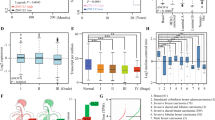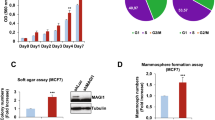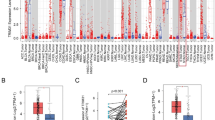Abstract
Basal-like breast cancer is a highly aggressive tumour subtype associated with poor prognosis. Aberrant activation of NF-κB signalling is frequently found in triple-negative basal-like breast cancer cells, but the cause of this activation has remained elusive.Here we report that α-catenin functions as a tumour suppressor in E-cadherin-negative basal-like breast cancer cells by inhibiting NF-κB signalling. Mechanistically, α-catenin interacts with the IκBα protein, and stabilizes IκBα by inhibiting its ubiquitylation and its association with the proteasome. This stabilization in turn prevents nuclear localization of RelA and p50, leading to decreased expression of TNF-α, IL-8 and RelB. In human breast cancer, CTNNA1 expression is specifically downregulated in the basal-like subtype, correlates with clinical outcome and inversely correlates with TNF and RELB expression. Taken together, these results uncover a previously undescribed mechanism by which the NF-κB pathway is activated in E-cadherin-negative basal-like breast cancer.
This is a preview of subscription content, access via your institution
Access options
Subscribe to this journal
Receive 12 print issues and online access
$209.00 per year
only $17.42 per issue
Buy this article
- Purchase on Springer Link
- Instant access to full article PDF
Prices may be subject to local taxes which are calculated during checkout






Similar content being viewed by others
References
Di Cosimo, S. & Baselga, J. Management of breast cancer with targeted agents: importance of heterogeneity. [corrected]. Nat. Rev. Clin. Oncol. 7, 139–147 (2010).
Perou, C. M. et al. Molecular portraits of human breast tumours. Nature 406, 747–752 (2000).
Sorlie, T. et al. Repeated observation of breast tumor subtypes in independent gene expression data sets. Proc. Natl Acad. Sci. USA 100, 8418–8423 (2003).
Prat, A. & Perou, C. M. Deconstructing the molecular portraits of breast cancer. Mol. Oncol. 5, 5–23 (2011).
Rakha, E. A., El-Sayed, M. E., Reis-Filho, J. & Ellis, I. O. Patho-biological aspects of basal-like breast cancer. Breast Cancer Res. Treat. 113, 411–422 (2009).
Perou, C. M. Molecular stratification of triple-negative breast cancers. Oncologist 16 (Suppl 1), 61–70 (2011).
Osborne, C. K. Tamoxifen in the treatment of breast cancer. New Engl. J. Med. 339, 1609–1618 (1998).
Slamon, D. J. et al. Studies of the HER-2/neu proto-oncogene in human breast and ovarian cancer. Science 244, 707–712 (1989).
Kobielak, A. & Fuchs, E. α-catenin: at the junction of intercellular adhesion and actin dynamics. Nat. Rev. Mol. Cell Biol. 5, 614–625 (2004).
The Cancer Genome Atlas Network, Comprehensive molecular portraits of human breast tumours. Nature 490, 61–70 (2012).
Onder, T. T. et al. Loss of E-cadherin promotes metastasis via multiple downstream transcriptional pathways. Cancer Res. 68, 3645–3654 (2008).
Derksen, P. W. et al. Somatic inactivation of E-cadherin and p53 in mice leads to metastatic lobular mammary carcinoma through induction of anoikis resistance and angiogenesis. Cancer Cell 10, 437–449 (2006).
Fodde, R. & Brabletz, T. Wnt/β-catenin signaling in cancer stemness and malignant behavior. Curr. Opin. Cell Biol. 19, 150–158 (2007).
Liu, T. X. et al. Chromosome 5q deletion and epigenetic suppression of the gene encoding α-catenin (CTNNA1) in myeloid cell transformation. Nat. Med. 13, 78–83 (2007).
Ji, H., Wang, J., Fang, B., Fang, X. & Lu, Z. α-Catenin inhibits glioma cell migration, invasion, and proliferation by suppression of β-catenin transactivation. J. Neurooncol. 103, 445–451 (2011).
Schlegelmilch, K. et al. Yap1 acts downstream of α-catenin to control epidermal proliferation. Cell 144, 782–795 (2011).
Silvis, M. R. et al. α-catenin is a tumor suppressor that controls cell accumulation by regulating the localization and activity of the transcriptional coactivator Yap1. Sci. Signal. 4, ra33 (2011).
Bajpai, S., Feng, Y., Krishnamurthy, R., Longmore, G. D. & Wirtz, D. Loss of α-catenin decreases the strength of single E-cadherin bonds between human cancer cells. J. Biol. Chem. 284, 18252–18259 (2009).
Yamaguchi, N. et al. Constitutive activation of nuclear factor-κB is preferentially involved in the proliferation of basal-like subtype breast cancer cell lines. Cancer Sci. 100, 1668–1674 (2009).
Baud, V. & Karin, M. Is NF-κB a good target for cancer therapy? Hopes and pitfalls. Nat. Rev. Drug Discov. 8, 33–40 (2009).
Pahl, H. L. Activators and target genes of Rel/NF-κB transcription factors. Oncogene 18, 6853–6866 (1999).
Hayden, M. S. & Ghosh, S. Signaling to NF-κB. Genes Dev. 18, 2195–2224 (2004).
Baltimore, D. Discovering NF-κB. Cold Spring Harb. Perspect. Biol. 1, a000026 (2009).
Karin, M., Yamamoto, Y. & Wang, Q. M. The IKK NF-κB system: a treasure trove for drug development. Nat. Rev. Drug Discov. 3, 17–26 (2004).
Basseres, D. S. & Baldwin, A. S. Nuclear factor-κB and inhibitor of κB kinase pathways in oncogenic initiation and progression. Oncogene 25, 6817–6830 (2006).
Hollestelle, A. et al. Four human breast cancer cell lines with biallelic inactivating α-catenin gene mutations. Breast Cancer Res. Treat. 122, 125–133 (2010).
Collart, M. A., Baeuerle, P. & Vassalli, P. Regulation of tumor necrosis factor α transcription in macrophages: involvement of four κB-like motifs and of constitutive and inducible forms of NF-κB. Mol. Cell Biol. 10, 1498–1506 (1990).
Kunsch, C. & Rosen, C. A. NF-κB subunit-specific regulation of the interleukin-8 promoter. Mol. Cell Biol. 13, 6137–6146 (1993).
Vincenti, M. P., Coon, C. I. & Brinckerhoff, C. E. Nuclear factor κB/p50 activates an element in the distal matrix metalloproteinase 1 promoter in interleukin-1η-stimulated synovial fibroblasts. Arthritis Rheum. 41, 1987–1994 (1998).
Matluk, N., Rochira, J. A., Karaczyn, A., Adams, T. & Verdi, J. M. A role for NRAGE in NF-κB activation through the non-canonical BMP pathway. BMC Biol. 8, 7 (2010).
Lien, W. H., Gelfand, V. I. & Vasioukhin, V. α-E-catenin binds to dynamitin and regulates dynactin-mediated intracellular traffic. J. Cell Biol. 183, 989–997 (2008).
Pickart, C. M. & Fushman, D. Polyubiquitin chains: polymeric protein signals. Curr. Opin. Chem. Biol. 8, 610–616 (2004).
Bren, G. D. et al. Transcription of the RelB gene is regulated by NF-κB. Oncogene 20, 7722–7733 (2001).
Gyorffy, B. et al. An online survival analysis tool to rapidly assess the effect of 22,277 genes on breast cancer prognosis using microarray data of 1,809 patients. Breast Cancer Res. Treat. 123, 725–731 (2010).
Ding, L. et al. Genome remodelling in a basal-like breast cancer metastasis and xenograft. Nature 464, 999–1005 (2010).
Kobielak, A. & Fuchs, E. Links between α-catenin, NF-κB, and squamous cell carcinoma in skin. Proc. Natl Acad. Sci. USA 103, 2322–2327 (2006).
Hu, Y. et al. Abnormal morphogenesis but intact IKK activation in mice lacking the IKKα subunit of IκB kinase. Science 284, 316–320 (1999).
Yan, J. et al. Inactivation of BAD by IKK inhibits TNFα-induced apoptosis independently of NF-κB activation. Cell 152, 304–315 (2013).
Ben-Neriah, Y. & Karin, M. Inflammation meets cancer, with NF-κB as the matchmaker. Nat. Immunol. 12, 715–723 (2011).
Gilmore, T. D. Introduction to NF-κB: players, pathways, perspectives. Oncogene 25, 6680–6684 (2006).
Karin, M., Cao, Y., Greten, F. R. & Li, Z. W. NF-κB in cancer: from innocent bystander to major culprit. Nat. Rev. Cancer 2, 301–310 (2002).
Pianetti, S., Arsura, M., Romieu-Mourez, R., Coffey, R. J. & Sonenshein, G. E. Her-2/neu overexpression induces NF-κB via a PI3-kinase/Akt pathway involving calpain-mediated degradation of IκB-α that can be inhibited by the tumor suppressor PTEN. Oncogene 20, 1287–1299 (2001).
Elenbaas, B. et al. Human breast cancer cells generated by oncogenic transformation of primary mammary epithelial cells. Genes Dev. 15, 50–65 (2001).
Stewart, S. A. et al. Lentivirus-delivered stable gene silencing by RNAi in primary cells. RNA 9, 493–501 (2003).
Yang, W. L. et al. The E3 ligase TRAF6 regulates Akt ubiquitination and activation. Science 325, 1134–1138 (2009).
Wang, W. et al. PTPN14 is required for the density-dependent control of YAP1. Genes Dev. 26, 1959–1971 (2012).
Acknowledgements
We thank S. Ethier (Medical University of South Carolina, USA) for the SUM159 cell line; J. Chen (The University of Texas MD Anderson Cancer Center, USA) for plasmids; the shRNA and ORFeome Core and the Histology Core at The University of Texas MD Anderson Cancer Center for technical assistance; J. Zhang and J. Chen for assistance with graphics; J. M. Rosen, X. Lin, W. Wang and members of the Ma laboratory for discussion; and H-l. Piao, C. Chu and A. Gelmis for editing the manuscript. This work is supported by US National Institutes of Health grants R00CA138572 (to L.M.) and R01CA166051 (to L.M.) and a Cancer Prevention and Research Institute of Texas Scholar Award R1004 (to L.M.).
Author information
Authors and Affiliations
Contributions
L.M. conceived and supervised the project. H-l.P. designed, performed and analysed most of the experiments. Y.Y. and H.L. performed computational data analysis. M.W. performed immunohistochemical staining and provided animal care. Y.S. maintained shRNA and ORF clones and provided significant intellectual input. H-l.P. and L.M. wrote the manuscript with input from all other authors.
Corresponding author
Ethics declarations
Competing interests
The authors declare no competing financial interests.
Integrated supplementary information
Supplementary Figure 1 α-catenin does not inhibit NF-κB signaling in E-cadherin-positive breast cancer cells.
(a) qPCR of CTNNA1, NFKBIA, RELB, IL8, TNF, SOD2 and BIRC3 in α-catenin-transduced MDA-MB-468 cells. n = 3 samples per group. (b) ELISA of TNFα and IL-8 secreted by α-catenin-transduced MDA-MB-468 cells. n = 3 wells per group. (c) Immunoblotting of α-catenin, RelB, IκBα, RelA, p105, p50 and HSP90 in α-catenin-transduced MDA-MB-468 cells. Data in (a) and (b) are the mean of biological replicates from a representative experiment, and error bars indicate s.e.m. Statistical significance was determined by a two-tailed, unpaired Student’s t-test. The experiments were repeated three times. The source data can be found in Supplementary Table 4. Uncropped images of blots are shown in Supplementary Figure 7.
Supplementary Figure 2 α-catenin does not regulate IKK phosphorylation in MDA-MB-157 cells.
Endogenous IKKη was immunoprecipitated from mock-infected or α-catenin-transduced MDA-MB157 cells and immunoblotted with antibodies to p-IKK and IKKη. Cells were treated with TNFα (20 ng/ml). Uncropped images of blots are shown in Supplementary Figure 7.
Supplementary Figure 3 α-catenin does not regulate IκBα, RelA and RelB protein levels in luminal-like mammary cells.
(a) Immunoblotting of α-catenin, IκBα, RelA, RelB and HSP90 in T47D and MCF10A cells transduced with two independent α-catenin shRNAs. (b, c) Immunoblotting of α-catenin, IκBα, p-RelA, RelA and HSP90 in α-catenin shRNA-transduced T47D (b) and MCF10A (c) cells, with or without TNFα treatment (20 ng/ml). Uncropped images of blots are shown in Supplementary Figure 7.
Supplementary Figure 4 α-catenin does not modulate β-catenin in basal-like breast cancer cells.
(a) Immunoblotting of α-catenin and β-catenin in cytoplasmic and nuclear fractions of BT549 cells transduced with two independent α-catenin shRNAs. (b) Immunoblotting of α-catenin and β-catenin in cytoplasmic and nuclear fractions of α-catenin-transduced MDA-MB-157 cells. α-tubulin and lamin A were used as cytoplasmic and nuclear markers, respectively, in (a) and (b). (c) Luciferase assays of β-catenin activity in MDA-MB-157 cells transfected with the Fopflash or Topflash luciferase reporter alone or in combination with α-catenin or β-catenin, or both. The Topflash construct contains multiple TCF/LEF-binding sites in the promoter of a firefly luciferase reporter gene and the derived Fopflash construct contains mutated TCF/LEF binding sites. n = 3 wells per group. Data in (c) are the mean of biological replicates from a representative experiment, and error bars indicate s.e.m. Statistical significance was determined by a two-tailed, unpaired Student’s t-test. The experiments were repeated three times. The source data can be found in Supplementary Table 4. Uncropped images of blots are shown in Supplementary Figure 7.
Supplementary Figure 5 α-catenin negatively correlates with NF-κB signaling components in human breast tumors.
(a) Box plots comparing CTNNA1 expression in normal breast tissues and in luminal A, luminal B and HER2+ breast tumors (n = 32, 13 and 4 patient samples, respectively). Statistical significance was determined by the Wilcoxon test. The boxes show the median and the interquartile range. The whiskers show the minimum and maximum. (b) Kaplan-Meier curves of relapse-free survival times of total breast cancer patients and patients with luminal A, luminal B or HER2+ breast cancer (n = 1370, 869 and 161 patient samples, respectively), stratified by CTNNA1expression levels. Statistical significance was determined by the log-rank test. (c) Scatterplots showing the inverse correlation of CTNNA1 with TNF (left panel) or RELB (right panel) expression in human breast tumors, based on the microarray data from TCGA. Statistical significance was determined by Spearman rank correlation test. Rs= Spearman rank correlation coefficient.
Supplementary Figure 6 α-catenin mechanisms of action.
(a) Cytoplasmic α-catenin and α-catenin localized to the cadherin-catenin complex regulate different pathways through different mechanisms. C: cytoplasm; N: nucleus; Ub: ubiquitin chain. (b) Immunoblotting of α-catenin, p-YAP, YAP and HSP90 in mock-infected and α-catenin-transduced MDA-MB-157 and MDA-MB-436 cells. Uncropped images of blots are shown in Supplementary Figure 7.
Supplementary information
Supplementary Information
Supplementary Information (PDF 969 kb)
Supplementary Table 1
Supplementary Information (XLSX 14 kb)
Supplementary Table 2
Supplementary Information (XLSX 13 kb)
Supplementary Table 3
Supplementary Information (XLSX 13 kb)
Supplementary Table 4
Supplementary Information (XLSX 36 kb)
Rights and permissions
About this article
Cite this article
Piao, Hl., Yuan, Y., Wang, M. et al. α-catenin acts as a tumour suppressor in E-cadherin-negative basal-like breast cancer by inhibiting NF-κB signalling. Nat Cell Biol 16, 245–254 (2014). https://doi.org/10.1038/ncb2909
Received:
Accepted:
Published:
Issue Date:
DOI: https://doi.org/10.1038/ncb2909
This article is cited by
-
Association of MARCH7 with tumor progression and T-cell infiltration in esophageal cancer
Medical Oncology (2022)
-
Identification of TUBB2A by quantitative proteomic analysis as a novel biomarker for the prediction of distant metastatic breast cancer
Clinical Proteomics (2020)
-
α-catenin SUMOylation increases IκBα stability and inhibits breast cancer progression
Oncogenesis (2018)
-
The IKK/NF-κB signaling pathway requires Morgana to drive breast cancer metastasis
Nature Communications (2017)
-
Beyond β-catenin: prospects for a larger catenin network in the nucleus
Nature Reviews Molecular Cell Biology (2016)



